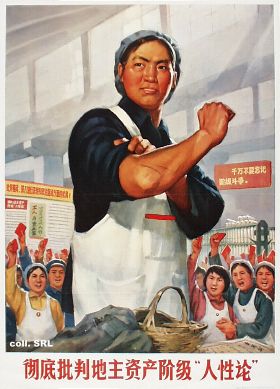
DapperQs know more than anyone the value of inspiring images of women with whom we can identify. The body can carry a wealth of ideological and social messages. In time, those messages take on new nuances, and the images themselves shift in our eyes. Many images of “masculine” women were produced in China in the 1960s, and they were read and re-read over time as people’s lived experiences shifted the cultural prism through which they were viewed. ‘Growing Up with Posters in the Maoist Era’, Xiaomei Chen’s complex and nuanced memoir of the Chinese Cultural Revolution, uses a series of posters to illustrate the complexity of cultural memory and identity. Here I’ll summarise the chapter for DapperQs interested in the global history of images of female masculinity.
“I grew up in a culture where posters remembered, talked back, and also constructed and reconstructed who I was and what was socially expected of me”
In the 1960s, no form of aesthetic expression was immune from suspicion, amid the fervor to eliminate feudal, capitalist and bourgeois culture from Maoist China. Images were scrutinized for counter-revolutionary messages, while public cultural activities such as school dance recitals were mired in questions about the propriety of their portrayal of gender and class. Born in Beijing into a family of theater artists, Xiaomei Chen was raised with a deep appreciation for cultural representations of society. Her family’s theater was widely celebrated for its portrayals of rural lower classes, who her parents took as moral examples in their private lives. She enjoyed an ambiguous double identity, coming from a family with extraordinary success and ordinary values. Her gender identity, formed from the images she saw around her, also allowed her to occupy an ambiguous, androgynous space which she found more complex and liberating than anything a single poster could portray.
Images fed Chen’s imagination, inspiring revolutionary ambition and national pride. She anonymously distributed posters at her school, went on weekend trips to galleries with her father, and helped to choose a poster of Mao for her family home. Gazing at the party leaders and crowds of supporters depicted in the images, Chen longed to be inside the image, to be part of the crowd, to be there as the history of her country unfolded before her. As a young tomboy, Chen re-enacted scenes from picture-books depicting the Japanese invasion, not unlike the way that cultural memory is replayed in European and American childhood games of Cowboys and Indians.
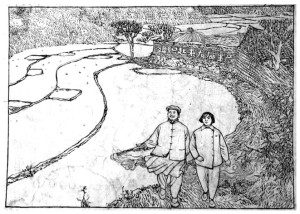
Her decision as a young woman to move to the countryside to spread the revolution was eased by her immersion in visual portrayals of rural landscapes, and of the strong, heroic, masculine women who worked there. “I remember gazing at the healthy, attractive body of Pretty Plum (Deng Xiumei), a female Communist Party worker [… who] lived among, and worked day and night for, peasants she hardly knew. I wanted to grow up and be just like her.” Years later, she re-read the same images of revolutionary women who she had once aspired to emulate, as hollow, cynical fantasies, in contrast to her friends’ lived experiences of poverty and decrepitude in rural China.
“I have no doubt that in my unconscious, posters became indelibly inscribed as part of my childhood world of wonders, my wanderings, and the emotions associated with growing pains… painting, poster, artifact, museum and national identities and narratives all became blurred, coalescing into the most valued memories of my childhood.”
Chen loved her mother’s femininity, as an actress who often wore high heels and fashionable dresses. She compares her mother’s body to that of “Wu Qinghua, the female revolutionary heroine whose long, straight legs and graceful body has resisted a vicious, oppressive landlord” as portrayed in the model ballet The Red Detachment of Women.
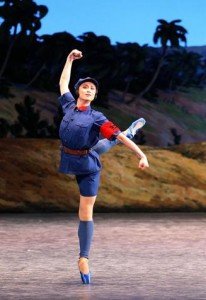
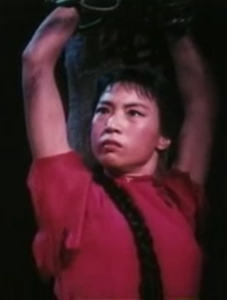
“Today, looking back, I am aware that my treasuring of these images was not unrelated to their voluptuous appeal and bodily beauty, which was securely disguised by … equipping the womanly body with a ‘manly spirit’.”
Wu Qinghua’s feminine body was often depicting carrying a ‘manly spirit’, leading to a politically loaded androgyny intended to stand in opposition to ‘bourgeois’ forms of female dress and behaviour. The ‘manly spirit’ of revolutionary images was further mobilized in oil paintings, posters and prints, in which the bagginess of the womens’ clothing accentuated the message of power and anti-bourgeois sentiment. At a time when images like this proliferated, Chen felt embarrassed to have such a feminine mother. In the complex balance between self, family and society, aspects of her own identity found expression in female masculinity.
“I do not know with any certainty how my idea of a [masculine] woman developed in my childhood, in that dynamic period when sexual ideology was always being reconstructed and revolutionary culture was defined in both traditional and nontraditional terms. Nor can I pinpoint when it was that I was ready to be drafted into serving the republic – I mean when I became the almost ideal Chinese “man”, physically, morally, and spiritually strong, with no uncomfortable sense of the conventionally defined antipodes of man and woman. What I do remember is […] how we all exerted ourselves to approximate […] heroic masculinity […] I went so far that my classmates began to tease me about my cross-dressing, but if they thought to win the teacher’s support with their mocking, they were disappointed. She criticized them. Declaring that there was nothing wrong with wearing boys’ clothing, she encouraged my androgynous act, claiming that it accorded with the simplicity exemplified by the [lower classes]. I then felt freer than ever to dress and act like a boy while trying to come out as the strongest and fastest at whatever we did, whether it was physical labour or phys ed exercises.
“Much later I would be interested to learn that cross-dressing as a boy could, in the words of Margorie Garber, ‘affirm the reality of pleasure, sexual and cultural’ and that clothing ‘contructs (and deconstructs) gender and gender differences, … power relations and career paths.’ Furthermore, one of the most important aspects of cross-dressing is the way it challenges facile binary notions, calling into question the categories of ‘female’ and ‘male’, as in the simplistic rule of pink for girls and blue for boys, in effect ‘since at least the 1940s’ in America, according to Garber. […] As for my precocious cross-dressing, I merely knew that I enjoyed the freedom entailed in acting the tomboy and tough, youthful revolutionary. Playing in my neighborhood after school, I vied for the opportunity to parade as a male hero to be executed by the Guomindang nationalists before 1949, confronting death without blinking, just like the fearless heroes in movies and picture books. I would then gladly sit down at the dinner table with my graceful mother and listen to her soft, feminine voice discussing recent theater productions with my father. I remember the indignation when I overheard some people attributing my mother’s femininity to foreign origin. After studying the photographs of my mother in the window of the China Youth Art Theater, one man said to his friend that my mother seemed too feminine to be Chinese. ‘Look at her shapely body,’ he said; ‘she was borrowed from the Soviet Union to act in a play.’ Young as I was, aged eleven, I could not keep from yelling, ‘She is not Russian. She is my mother!’ Before they had a chance to question me about my origins, I ran home, scared but very proud, to my mother and father, and to our warm house. Home was the place where femininity and masculinity did not have to be interrogated […]
“In time I indulged in additional role-playing, when the dark blue and gray of my boyish clothing gave way to ‘girlish’ colors of various shades of red. On the eve of International Children’s Day, 1 June 1964, I reveled in wearing a red hat, red leather shoes, and golden short skirt with white lace while playing the title role in our school’s English production of Little Red Riding Hood. I could not have known then, of course, what Margorie Garber meant by referring to Little Red Riding Hood as one of the most frequently interpreted stories in the West. It has been viewed by many literary experts as ‘the primal scene of narrativated cross-dressing,’ in which the wicked wolf dresses up as a woman, the benign grandma, who ‘terrifies and pleases, seduces and warns.’ Nor could I have understood that Little Red Riding Hood belongs to the ‘very existence of transvestite theaters, from Shakespeare’s cross-dressed ‘heroines’ to the contemporary drag show’ that ‘testifies to the primacy of cross-dressing as spectacle, as that which purports both to conceal and to reveal.’ What was revealed to me, however, was my culture’s version of the story’s moral: we should never be taken in by our national enemy, who could cross-dress as our friend.”
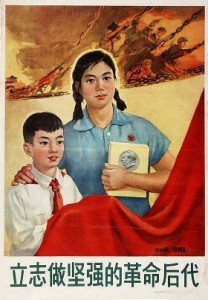
Chen’s “stylish cape” had been made by her teacher from a red flag. A relationship between clothing and the flag was drawn in the Young Pioneers, similar to the scouts, whose red scarves were described as, “a corner of the red flag that had been colored with the warm blood of revolutionary martyrs.” As a Young Pioneer, Chen’s identity as an aspiring revolutionary and as a tomboy flourished; “I can still identify with the boy solemnly holding the red flag in [images such as] Determined to be strong revolutionary successors (1965 [shown above]) […] I have no horror stories from that period, and no sense of constraint to mar my heightened memories of seeing bright red everywhere around me. Red was my favorite color. Collectively and personally, it made the best sense.”
The Chinese Communist Party was overwhelmingly male-dominated, and political posters always depicted a patriarchal authority unchallenged by their fellow revolutionary women. Nevertheless, when Chen was growing up she felt as though the male and female worlds were significantly blurred. “[P]erhaps, as my story of crossdressing suggests, no matter how binary the society that was supposed to be in the making, there was almost always some room in between in which to transgress mainstream codes of behaviour as they related to gender or other societal norms.”
As a Professor of Chinese literature and culture, Xiaomei Chen argues that posters from the Chinese Cultural Revolution complicate American discourses about political correctness, which often merely repeat pro-women tropes from the maoist era rather than advancing anything truly progressive. However, she also wants to defend the liberal agenda, and points out that there is nothing wrong with trying to create a space in America for ideas that are currently unrepresented. Her approach is to show that posters can construct and deconstruct cultural ideas about a range of topics, including gender. By including many voices speaking authentically about their most meaningful historical memories, she aims to account for complex, hybrid forms of identity.
This post is a summary of Xiaomei Chen’s ‘Growing Up with Posters in the Maoist Era’, from Evans and Donald eds. Picturing Power in the People’s Republic of China: Posters of the Cultural Revolution




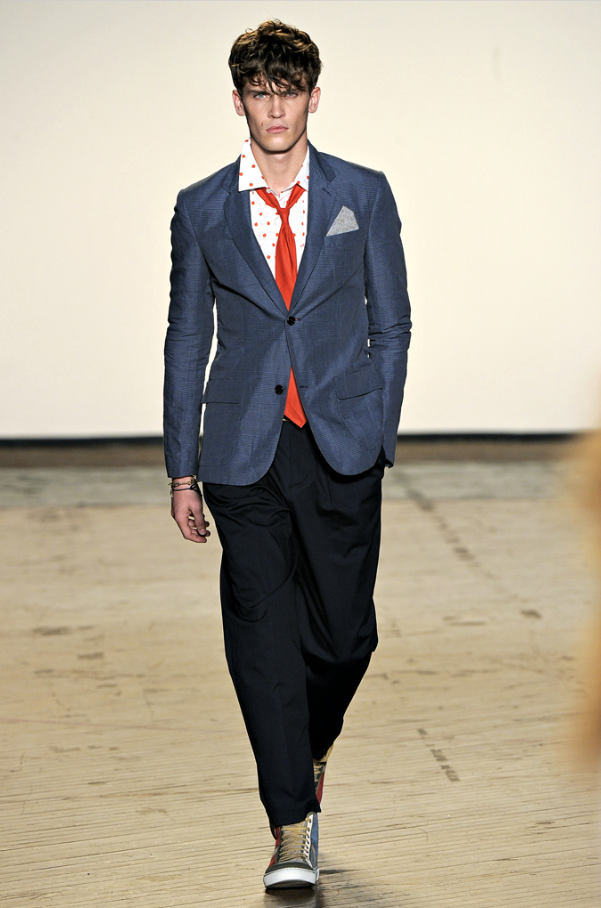
1 Comment